Google Nexus 4 Review - Google's new Flagship
by Brian Klug on November 13, 2012 8:45 AM EST- Posted in
- Smartphones
- LG
- Android
- Mobile
- APQ8064
- Nexus 4
- Android 4.2
- MDM9215
Battery life in the Nexus 4 is a big concern for many, especially since the Nexus 4 isn’t designed to have a user replaceable battery. What’s inside is a 2100 mAh 3.8V battery which is 8.0 watt-hours. I had been wondering for a while what the chemical compound used in the 3.8V battery cells we’re seeing emerge was, and finally got a tad more info at least about the LG Chem approach. This is the higher voltage chemistry from LG Chem which is Lithium Cobalt Oxide (LiCoO2) based and includes electrolyte additives to prevent gas generation in the cell which affects lifetime during high temperature periods. Although getting the back off of the Nexus 4 is relatively easy and requires just removing two Torx 4 screws and prying up on the plastic, I doubt anyone is going to make a back to accommodate an extended battery due to the presence of 4 antennas which are integrated into the back cover.
The Nexus 4 incorporates wireless charging into that back alongside NFC. For wireless charging the Nexus 4 uses a TI BQ51051b wireless power Li-Ion charger receiver. I’ve been pretty remiss in looking into wireless charging and actually trying it myself, so I went ahead and bought a two-position Energizer Qi compliant charging mat.
The Nexus 4 is Qi 1.1 wireless charging forum compliant, so any charger that is Qi compliant or includes the logo will charge it. Aligning the Nexus 4 on the Energizer mat is a bit tricky since the surface is slick and angled down, and the back of the Nexus 4 is primarily glass, but it isn’t difficult after you know where to align. The Nexus 4 charges from fully discharged to completely charged in 3.033 hours on the Qi mat, which is basically the same charge time as I saw off of microUSB on a BC 1.2 charger.
In Android you’ll see Charging (Wireless) when this mode is employed. I used the Palm Pre touchstone charger a lot back in the day and saw that get pretty hot during a charge cycle. The Nexus 4 doesn’t get nearly as warm. I’ve noticed that at the top of the charge cycle you’ll see the Nexus 4 selectively draw power from the charging dock since there doesn’t seem to be an equivalent trickle charge mode or something, but this is normal.
Battery Life
I’ve had the chance to run more battery life tests on the Nexus 4, and run the cellular test a few more times. The results are quite consistent and we don’t see that result change very much at all. I’ve also added the call time test and tethering results.
We regularly load web pages at a fixed interval until the battery dies (all displays are calibrated to 200 nits as always). The differences between this test and our previous ones boil down to the amount of network activity and CPU load.
On the network side, we’ve done a lot more to prevent aggressive browser caching of our web pages. Some caching is important otherwise you end up with a baseband test, but it’s clear what we had previously wasn’t working. I’ve made sure that despite the increased network load, the baseband still has the opportunity to enter its idle state during the course of the benchmark, we’re not destroying the RRC states with too aggressive of a load time.
We also increased CPU workload along two vectors: we decreased pause time between web page loads and we shifted to full desktop web pages, some of which are very JS heavy. The end result is a CPU usage profile that mimics constant, heavy usage beyond just web browsing. Everything you do on your smartphone ends up causing CPU usage peaks - opening applications, navigating around the OS and of course using apps themselves. Our 5th generation web browsing battery life test should map well to more types of smartphone usage, not just idle content consumption of data from web pages.
As always we test across multiple air interfaces (3G, 4G LTE, WiFi), but due to the increased network load we actually find that on a given process technology we see an increase in battery life on faster network connections. The why is quite simple to understand: the faster a page is able to fully render, the quicker all components can drive down to their idle power states. All Android tests use Chrome and 5GHz WiFi unless otherwise listed.
The tethering test still consists of four tabs of the webpage tests in conjunction with a 128 kbps streaming MP3 radio station over the smartphone’s personal WiFi hotspot.
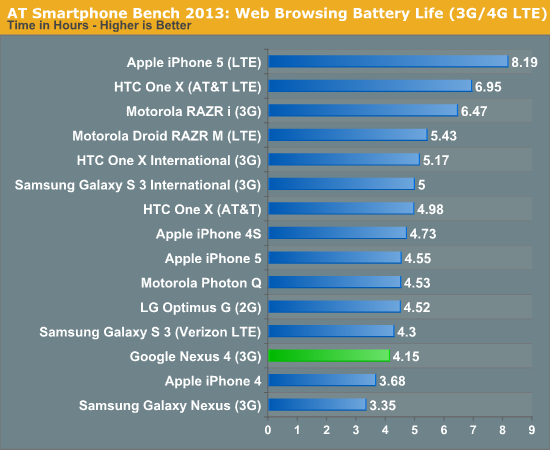
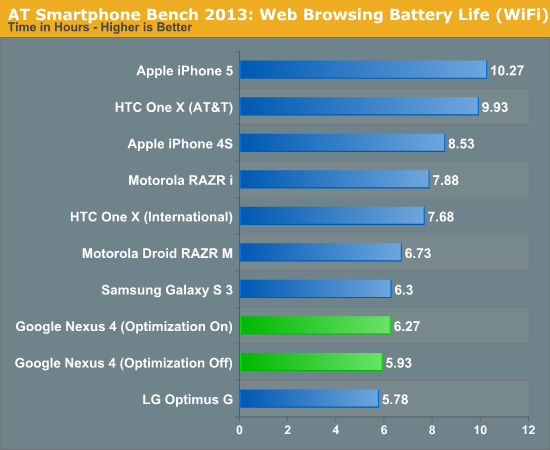
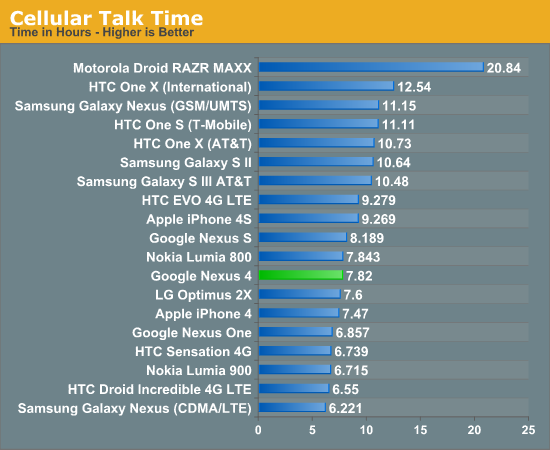
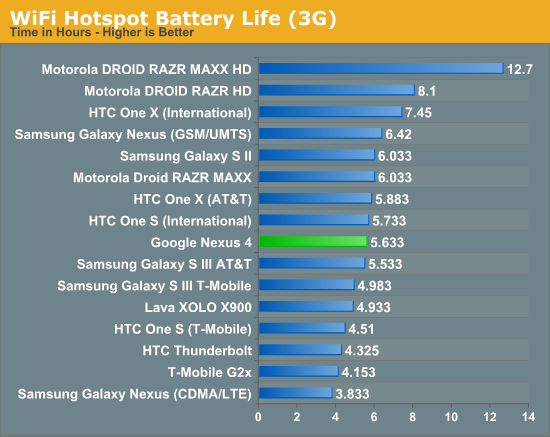
I've run and re-run the battery life tests on the Nexus 4 and they haven't changed since our preview a whole bunch. The result is battery life that isn't really chart topping, yet in my time with the Nexus 4 I haven't really been want for more battery life at any point. I'm able to get through a single day with the device set on auto brightness.



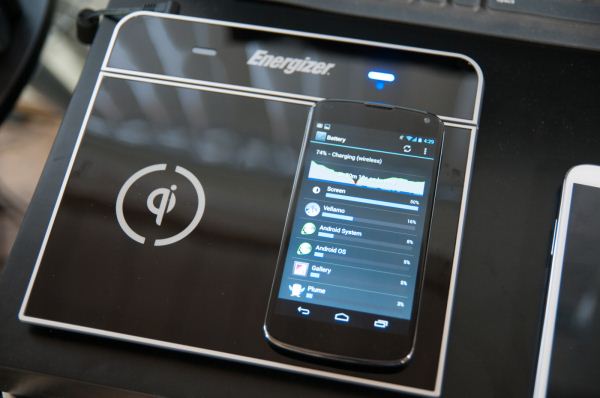

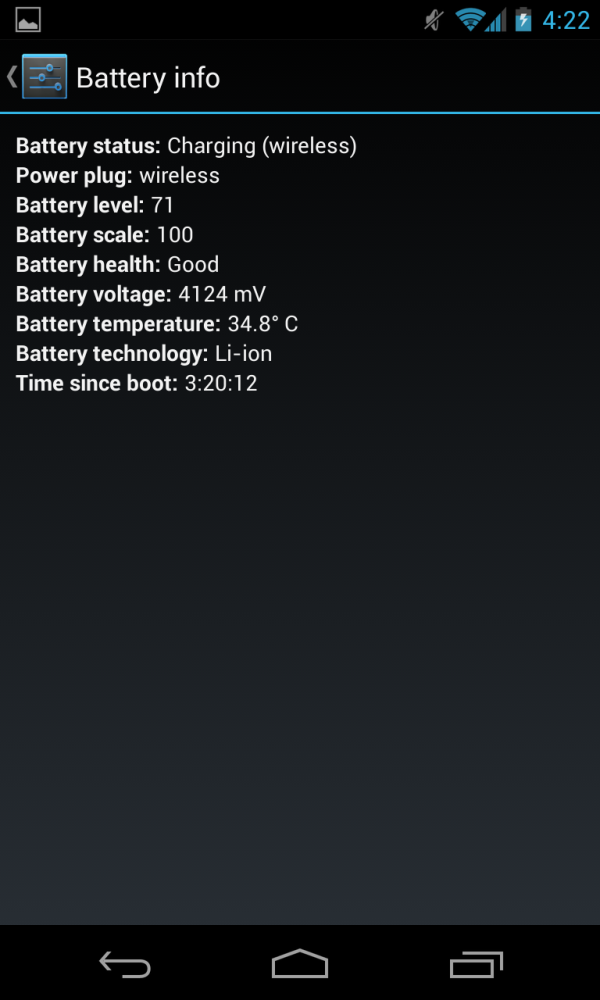








188 Comments
View All Comments
chrnochime - Tuesday, November 13, 2012 - link
I did and it just mentioned that it gets streaks on the bottom genius. Did YOU RTFR?Rits - Tuesday, November 13, 2012 - link
Do you know what brittle means? Streaks? Where did you read streaks? I read "sleeks" which are fine scratches (if you'd RTFR).tuxRoller - Tuesday, November 13, 2012 - link
According to other reviews, yes, it is quite brittle (the verge dropped it from a table to a hard wood floor and a spidery crack emerged from the corner to the camera module and that wasnt the onlg review that had problems with durability).A case is highly suggested.
Impulses - Tuesday, November 13, 2012 - link
That's a big turnoff IMO. I'd love to see a poll on AT to find out what percentage of readers actually uses cases or not tho...I find myself tempted every year to go caseless but I never end up doing it for several reasons. Slim TPU cases allow me to put the phone down screen first without worrying about it, and it protects the camera too. Cases also help mitigate impact from drops and protect my resale value too...
Basically I could care less for in hand feel, gonna be feeling the case anyway. I'd rather just have an all around sturdier phone. I can appreciate the design of something like the One X over most Samsung designs but it's not a huge deal to me.
Hell I don't even think my EVO LTE is as fugly as some make it out to be, and the metal build seems rather solid.
tuxRoller - Wednesday, November 14, 2012 - link
IIRC, the verge mentioned something about Google releasing some kind of case that mainly protects the corners (I think they said it was something like the case apple put out for the iphone 4), but I could be mistaken.I've a nexus s and I've never used a case and the phone looks pretty much brand new (the screen did break awhile back after cat shot [as in, he was running, phone was in the way] the phone onto ceramic tile floor in the kitchen...so, about as nasty a fall as a phone will take). For the nexus 4, which I'm going to get, I will almost certainly get a case.
About the build quality, something that others have mentioned, and reviewers frequently forget (though not so much here), is that in hand feel has relatively little to with how well the device will survive impacts.
The iphone 4/s had great in hand feel but the damn thing is brittle as all hell.
Samsung phones, while "plasticy", survive drops well (excepting the latest generation, apparently). However, you should keep in mind I actually like the in-hand feel of my nexus. It has almost no sharp angles and sits so comfortably in hand, and slides in and out of my pocket so easily.
Baroobob - Tuesday, November 13, 2012 - link
"We now have a form factor of device for every two inches of diagonal difference."Should be every three inches assuming you're referring to Nexus 4, 7, 10.
Zink - Tuesday, November 13, 2012 - link
I was confused at well.andybryant - Tuesday, November 13, 2012 - link
Does it support USB OTG without needing 3rd-party software or re-flashing?i.e. to allow me to read/write to an external USB key or SD card in reader.
MadMan007 - Tuesday, November 13, 2012 - link
Good question! If so, it alleviates much of the 'no SD slot' pain.thesavvymage - Tuesday, November 13, 2012 - link
yeah this is something I'd like to know as well. I still bought it, but the only thing I'm having worries about is being able to take a usb full of movies on it for a flight or something. A super short OTG cable and one of those USB drives that sticks out like 2mm would be great.In the end, if not supported out of the box (like the N7) then ill just root and use stickmount